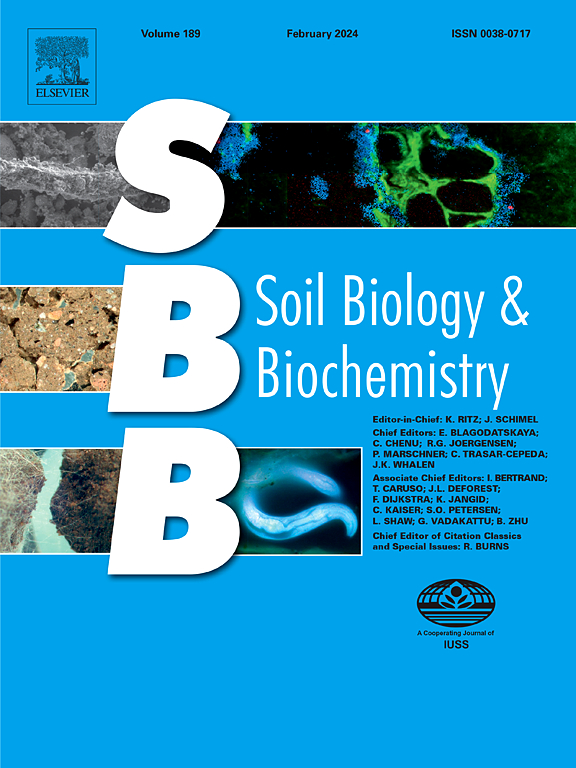Whole soil warming promotes surface soil carbon loss but deep soil carbon gain, depending on land management practices in temperate climate
IF 9.8
1区 农林科学
Q1 SOIL SCIENCE
引用次数: 0
Abstract
The impact of management practices on the response of biogeochemical cycles to soil warming remains poorly understood. This study aimed to investigate (1) the effects of warming on soil organic carbon (SOC) and nitrogen (N) storage across soil profiles in cropland and grassland and (2) the microbial metabolism involved in these processes. To achieve these objectives, we conducted an in-situ soil warming experiment (+4°C) down to 1.0-m depth in an agricultural Cambisol in Lusignan, France. We analyzed soil microbial community composition using ester-linked fatty acid methyl ester (EL-FAME) profiling and measured extracellular enzyme activities related to SOC and nutrient cycling under both land management practices.
Our results indicated that three years of soil warming had no effect on SOC and N stocks in grassland soils across the profile. In contrast, cropland surface soils (0-15 cm) showed an 18.1% and 15.0% decrease in SOC and N stocks, respectively, while deeper layers (70–90 cm) exhibited an 86.7% and 68.8% increase. These shifts in SOC and N stocks corresponded with changes in extracellular enzyme activities (C- and N-acquisition), eco-enzymatic stoichiometry, and bacterial community composition. Additionally, warming led to a slight decrease in aboveground biomass production in cropland. Furthermore, microbial biomass and community composition in surface soil exhibited management-specific responses to warming. Overall, our findings suggest that the effect of warming on SOC and N stocks depends on both soil depth and land management. Consequently, agricultural management practices could regulate SOC responses to warming by altering carbon inputs into the soil system, with implications for microbial community composition and activity.


全土壤变暖促进表层土壤碳损失,但深层土壤碳增加,这取决于温带气候下的土地管理做法
管理措施对生物地球化学循环对土壤变暖的响应的影响仍然知之甚少。本研究旨在探讨(1)气候变暖对农田和草地土壤有机碳(SOC)储量的影响,以及参与这一过程的微生物代谢。为了实现这些目标,我们在法国吕西尼昂的一个农业Cambisol进行了1.0 m深度的原位土壤升温实验(+4°C)。利用酯链脂肪酸甲酯(EL-FAME)分析了两种土地管理方式下土壤微生物群落组成,并测量了与有机碳和养分循环相关的胞外酶活性。结果表明,3年的土壤增温对草地土壤有机碳和氮(N)储量没有影响。农田土壤有机碳和氮储量在表层(0 ~ 15 cm)分别减少18.1%和15.0%,深层(70 ~ 90 cm)分别增加86.7%和68.8%。这些变化与细胞外酶活性(C-和N-获取)、生态酶化学计量学和细菌群落组成的变化相对应。此外,气候变暖导致农田地上生物量产量略有下降。此外,表层土壤微生物生物量和群落组成对气候变暖表现出特定的管理响应。总体而言,我们的研究结果表明,变暖对有机碳储量的影响取决于土壤深度和土地管理。因此,农业管理措施可以通过改变土壤系统的碳输入来调节有机碳对变暖的响应,从而影响微生物群落的组成和活动。
本文章由计算机程序翻译,如有差异,请以英文原文为准。
求助全文
约1分钟内获得全文
求助全文
来源期刊

Soil Biology & Biochemistry
农林科学-土壤科学
CiteScore
16.90
自引率
9.30%
发文量
312
审稿时长
49 days
期刊介绍:
Soil Biology & Biochemistry publishes original research articles of international significance focusing on biological processes in soil and their applications to soil and environmental quality. Major topics include the ecology and biochemical processes of soil organisms, their effects on the environment, and interactions with plants. The journal also welcomes state-of-the-art reviews and discussions on contemporary research in soil biology and biochemistry.
 求助内容:
求助内容: 应助结果提醒方式:
应助结果提醒方式:


